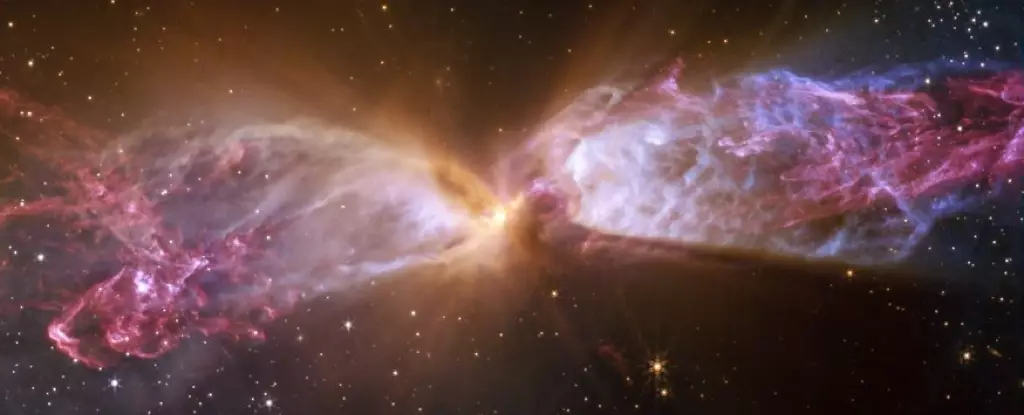In the vast expanse of the universe, young stars exhibit behavior that can be likened to a child’s exuberance—untamed and unpredictable. A spectacular snapshot captured by the James Webb Space Telescope (JWST) reveals the striking development of two nascent stars located approximately 650 light-years away in the Lynds 483 star-forming region. The image showcases a breathtaking hourglass shape sculpted from tumultuous energetic jets that collide with disturbingly raw clouds of gas and dust. The sheer power and chaotic beauty of these young stars breathe life into their stellar nurseries, making them one of the most riveting subjects for astronomical inquiry.
The formation process of stars such as these is a complex interplay of gravitational forces and environmental dynamics. As nascent stars absorb surrounding materials, primarily gas and dust, they undergo a remarkable transformation—growing in mass and luminosity. Some stars can reach astonishing scales, boasting masses exceeding 200 times that of our Sun. However, the process of star development is not merely a feast of consumption; it equally involves the release of energy and matter. Powerful jets, emanating from the polar regions of these young giants, eject material back into the cosmos, demonstrating a two-way flow of cosmic matter. This fascinating aspect reflects not only the dynamic nature of star formation but also its long-term implications for the surrounding interstellar medium.
Insights from the James Webb Space Telescope
The JWST stands as the tallest lighthouse in the dark expanse of space exploration. Its unmatched resolution and ability to penetrate infrared light have allowed it to probe areas that were shrouded in obscurity, unveiling incomprehensible phenomena. In the case of Lynds 483, which houses significant concentrations of gas and dust that conceal the birth of stars, the JWST has shed light on the intricate processes that shape the cosmos.
Observe how this telescope captures the swirling accretion disks around forming stars—a structure that constitutes not only the building blocks of the stars themselves but also the very essence of their nature. While some material from this disk fuels stellar growth, much is steered by powerful magnetic fields toward the stars’ poles, resulting in the striking jets that define young stars such as those observed in L483. These jets are not constant; their intermittent nature reflects the sporadic patterns of accretion that characterize young stellar objects.
The jets propel matter at staggering velocities, sometimes reaching several hundred kilometers per second, sculpting the surrounding gas into dynamic hourglass shapes rich with chemical compounds. Each collision of matter—older ejections meeting newer ones—generates complex patterns that hint at the future potential of organic molecules, which could one day play a role in the development of life.
The Rich Chemistry of Star Formation
Within these chaotic clouds of gas and dust lies a hidden treasure of chemical reactions, resulting in various organic compounds, including methanol and carbon dioxide. Insights gathered from studies conducted in 2019 reveal that these chemical processes take place primarily in the core regions closest to the protostars—known as “hot corinos.” These vital areas reveal a rich tapestry of emerging compounds, offering tantalizing hints about the building blocks of life as we know it.
Yet, there remains a plethora of enigmas surrounding the star-forming region of Lynds 483. Its hourglass shape, while partially symmetrical, exhibits asymmetrical features that continue to puzzle astronomers. The JWST’s remarkable capabilities allow for an exploration of this cosmic puzzle, revealing fine details and structures previously hidden from our view. Images captured show an array of tangled filaments, a chaotic jumble that underscores the complexity inherent in environments where new stars emerge.
The Future of Stellar Evolution
The journey of the protostars hidden within L483 is set to unfold over millions of years, ultimately leading these stellar infants into adulthood as main-sequence stars, similar in type and mass to our Sun. The hourglass-shaped jets and gas will be swept away in the course of their evolution, leaving behind a more serene environment punctuated by the quiet formation of planets around the established stars. In the far future, these stars could serve as critical catalysts for planetary systems, a tantalizing proposition for the study of exoplanets and potential life.
As we contemplate these far-off futures, one cannot help but wonder about the future of astronomical observation itself. The JWST, while a pinnacle of human ingenuity today, may one day fade into obscurity like the stars it studies. New technology and methodologies will emerge, allowing humanity to unravel even deeper mysteries of the cosmos, enabling us to comprehend our place in the vast universe.
In this cosmic dance of creation and destruction, of chaos and order, the story of Lynds 483 serves as a vivid reminder of the beauty and complexity of the universe—inspiring wonder and driving the quest for understanding that has always defined humanity’s reach for the stars. As we unravel these mysteries, the essence of creation unfolds before our very eyes, reminding us that the narrative of the universe is both a scientific endeavor and a deeply personal journey.

